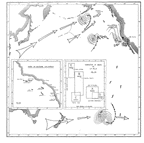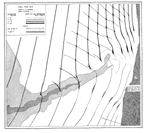

Lecture 18 - The Ocean:
Currents, Waves, and Tides
David Sandwell and Lisa Tauxe
Chapter 8 of the Blue Planet covers some of the material in this lecture but I have taken most of my notes from an excellent introductory book.
What is a western boundary current? Were are two prominent western boundary currents?
Describe the Antarctic Circumpolar Current (called West Wind Drift in Blue Planet)?
Why is upwelling important for sea life?
Why are the waves at Blacks Beach usually better than the waves at La Jolla Shores for surfing?
The main thing about oceans is that the water is in constant motion. There are large currents in the ocean, both in map view and vertically as well. This "stirring" is extremely important to us humans as we shall see. There are two major sources of energy for driving ocean currents: the sun (via wind) and density (via salt content and temperature). First we will consider the force of the winds.
The source of energy for wind is the heat from the sun. The sun warms the air in the topics. This creates a temperature difference between the equator and the pole and of course the air "wants" to even things out. In fact, this tendency is a fundamental law of physics. Thus, heat will always flow from warmer to cooler regions and the air attempts to do this too. Another fundamental law of physics is that things once started moving, will travel in straight lines. This is impossible on the surface of a globe, but the air does the best it can, tracing out what appears to be a curve on the surface of the globe. Also, since the Earth is rotating we have a third law of physics and that is that "angular momentum is conserved". This is the same reason that a skater twirls faster as her arms are brought closer to her body. In a nutshell, things bend to the right in the northern hemisphere and to the left in the southern hemisphere.
Finally, warm air rises. This is because the air molecules have more energy, and bounce harder against one another, causing the air mass to expand. There is less mass per unit volume; hence the air is less dense and rises. The upshot of all this physics is that air rises at the equator and is replaced by air from the surrounding material. This makes the northeast (bending to the right (southwest) as it comes from the north) and southeast trades (bending to the left (northwest as it comes from the south). The illustration below shows ocean surface temperature - cold at the poles and hot along the equator.

Now how does wind drive water. It is simple - it pushes it! However, water also is affected by the coriolis force and so the great ocean currents are big circles. And here they are:

The other main driving force for ocean currents is density. When water gets saltier and colder, it gets denser and sinks. A good way to make really dense water it to form ice. It happens when water is good and cold and the ice preferentially excludes salt, so the remaining water gets saltier. If the water gets cold enough and salty enough, it sinks right to the bottom. [Ice of course floats, so there is a density maximum at some temperature just above freezing]. The deep water then travels along the ocean floor in great currents:
Water returns to the surface in places called upwelling zones where water is being displaced by the action of winds (for example over the equator and along the California coast).
Nutrients are used by biological organisms. These live predominantly in surface waters because they are either plants (which need sunlight), eat plants, or eat things that eat plants. When the organism dies, the organic material rich in nutrients falls down by gravity taking the nutrients with it. The organic material decomposes in the depths of the ocean, returning the nutrients to the water. Therefore, the surface waters become depleted in nutrients and the deep waters become enriched.
If there were no way for the deep water to return to the surface, the surface ocean would run out of nutrients and everything would die. Then we would die, because plants in the sea are the primary source of oxygen in the atmosphere. We also would have no more fish and chips!
Fortunately, because of the kindly action of wind, water circulates in the ocean and there are regions of upwelling. Referring to the picture above, you will notice that these regions (marked by XXX's) are also the major regions of fishing. (see also this link about modeling of winds and ocean currents)
http://www.acl.lanl.gov/GrandChal/GCM/gcm.html